Improving Sustainable Forest Management of Pinus halepensis Mill. Mid-Aged Stands in a Context of Rural Abandonment, Climate Change, and Wildfires
Abstract
1. Introduction
- To analyze the effect of each silvicultural treatment on the growth and stock evolution of the stands.
- To analyze the damage caused by perturbances (wind, snow) concerning the applied treatment.
- To evaluate the natural regeneration of pine trees and shrubs in each silvicultural treatment.
- To check the accuracy of the existing yield tables for this species in the selected areas.
2. Materials and Methods
2.1. Study Area
2.2. Experimental Plots and Silvicultural Treatments
- (a)
- Soil (rock and deepness);
- (b)
- Orography (orientation, soft, and even slope);
- (c)
- Climate (near the location of the different research plots);
- (d)
- Stands (even-aged stands afforested in the same year with the same species and with no significant thinning applied before).
- Light thinning (LT): All trees of Kraft classes 4 and 5 were removed, as well as those of class 3, unless excessive understocking in the stand would be created. In addition, the most vigorous and best-positioned trees were preselected, identifying them as possible seed trees for future natural regeneration. Thus, those of classes 1 and 2 of poorer quality that may interfere with each other would be removed. Trees with any health issues would also be removed. The applied thinning intensity was derived from the yield table for this species published by [16] for light thinning.
- Strong thinning (ST): All trees of Kraft classes 3, 4, and 5 were removed unless excessive understocking in the stand was created. Trees of classes 1 and 2 were only eliminated for health reasons, overstocked stand density, or if they show poor quality. The applied thinning intensity was derived from the yield table for this species published by [16] for strong thinning.
- Transformation to uneven-aged (TU): Trees were systematically removed according to quality criteria and phytosociological position. All trees of Kraft classes 4 and 5 were removed, as well as those of class 3, if they were of low quality. Trees of classes 1 and 2 with poor quality or presenting health issues were eliminated unless an excessive understocking in the stand was created. In stands with a high density of trees of classes 1 and 2, these were removed following quality and space distribution criteria to facilitate regeneration.
- Diameter-driven uneven-aged (DU): Trees with the largest diameter were removed, while those with a lower diameter were left standing. The target diameter chosen was 23 cm (DBH) without felling any trees below that diameter except for the dead ones. If the gap left after the felling creates an equivalent space larger than three dominant trees, the most centric or stable tree will be left standing.
- Control plots (CP): Only dead or almost trees were removed (class 5), counted as natural mortality.
- LT and ST are the standard treatments in mid-aged and even-aged stands. Before engaging into new thinning pathways and considering the relatively high age of the stands (50 years) in relation to the rotation age in this species (80–100 years) for applying a first thinnings, the most prudent option was to test, for the first time in a research plot setting, the thinning intensities of the previously quoted yield table.
- TU: Pinus halepensis is not predisposed to uneven-aged structures, as it is a light species. This treatment is considered suitable in at least three cases: steep slopes due to high erosion potential and increased light availability, small-scale ownership, and as a transitional option for extensive mid-age afforestation to speed up the diversification of age classes and structures. The small-scale stand diversity in steep slopes would risk masking the results, recommending the establishment of research plots of uneven-aged treatments in almost flat conditions such as the ones of these research plots.
- DU: In the past, the standard treatment was diameter-driven uneven-aged selection with 23 cm as the minimum diameter. While this practice had been phased-out in public forests in the past decades, it remained the standard in private ones. Professional foresters have shared strong criticism regarding the degradation risks of this treatment, especially about the stand stability, growth potential, and genetics [30]. Ex-ante exclusion of long-applied treatment without due research-based checking was considered premature.
- CPs are foreseen in silvicultural treatment plots as a standard practice to allow comparisons with non-treated stands.
2.3. Stand Characterization Based on Forest Growth Parameters
- Stand density (trees/ha): This is defined as the number of living trees with a DBH >7.5 cm at 1.30 m high present in each plot per hectare.
- Basal area (BA or G, in m2 or m2/ha): This is defined as the cross-sectional area of the normal diameter of a tree or all trees per hectare at 1.30 m high of a stand. It is a good thickness estimator if it is combined with the dominant diameter and the mean square diameter [31]. It can be calculated with the following expression (1):
- Quadratic mean diameter (Dq, in cm): This corresponds to the mean basal area diameter of each plot (Gm). It can be calculated with expression (2):
- Quadratic mean height (Hq, in m): This corresponds to the mean height of the mass. This height also corresponds to that of the mean basal area tree.
- Dominant diameter (Dd, in cm). This corresponds to the diameter of the 100 thickest trees per hectare. The quadratic means of the diameters of the 49 thickest trees of each one are calculated to obtain the dominant diameter per plot.
- Dominant height (Hd, in cm): This corresponds to the tree’s height with the average normal section of the thickest 100 trees per hectare. The thickest 49 trees per plot are selected, and the mean square of their heights is calculated.
- Volume with bark (Vwb, in m3 or m3/ha): This is calculated based on the formula obtained from the last available National Forest Inventory (3rd) released just a few years before the plots were set-up [32] for the forest district to which the study area belongs (Province of Valencia). The ratio is individually applied for each tree in the plot, and these unit volumes are subsequently added to gather the total volume per plot. It can be calculated with expression (3):
- Slenderness (h/d, as a %): Ratio between the total height and the normal diameter. Slenderness index is a stability indicator for which values below 80 indicate good stability, whereas values between 81 and 100 show some instability and values above 100 represent a high instability [31]. The average slenderness index of the plot corresponds to the arithmetic mean of the individual slenderness indexes of all the trees [33]. The individual slenderness index can be calculated with expression (4):
- Unitary volume of the average tree (Vt, in m3/tree): The volume corresponding to the average tree of a stand, calculated as the quotient between the total volume of the plot and the number of trees.
- Periodic growth (pg): This represents the periodic growth of a tree parameter. It is also known as Periodic Annual Increment (PAI) or Periodic Annual Growth. Periodic growth can be calculated with expression (5):
- Average periodic growth (apg): This is an expression of the accumulated growth divided by the age. It is also called Mean Annual Increment (MAI) or Mean Annual Growth. It can be calculated with expression (6):
- Regeneration is counted before reaching 0.25 m as the smaller juveniles often dry out due to the lack of light in excessive shadow.
- Regeneration and shrub cover, including the dominant species, are measured by inventory subplots of 4% of the area of each research plot.
3. Results and Discussions
3.1. Analysis of Growth Differences among Silvicultural Treatments
3.2. Impact of Extreme Weather Events of 2010 and 2017
3.3. Regeneration and Shrub Cover Evaluation by Treatment
4. Conclusions
Supplementary Materials
Author Contributions
Funding
Data Availability Statement
Acknowledgments
Conflicts of Interest
References
- Fady, B.; Semerci, H.; Vendramin, G.G. EUFORGEN Technical Guidelines for Genetic Conservation and Use for Aleppo Pine (Pinus halepensis) and Brutia Pine (Pinus brutia); Bioversity International: Rome, Italy, 2003; Available online: https://www.bioversityinternational.org/fileadmin/user_upload/online_library/publications/pdfs/858.pdf (accessed on 18 January 2023).
- Mauri, A.; di Leo, M.; de Rigo, D.; Caudullo, G. Pinus halepensis and Pinus brutia in Europe: Distribution, Habitat, Usage and Threats; European Atlas of Forest Tree Species. Publ. Off. EU: Luxembourg, 2016; Available online: https://forest.jrc.ec.europa.eu/media/atlas/Pinus_halepensis_brutia.pdf (accessed on 18 January 2023).
- Farjon, A. A Handbook of the World’s Conifers; Brill Publishers: Leiden, The Netherlands, 2010. [Google Scholar] [CrossRef]
- De Luis, M.; Čufar, K.; Di Filippo, A.; Novak, K.; Papadopoulos, A.; Piovesan, G.; Rathgeber, C.B.K.; Raventós, J.; Saz, M.A.; Smith, K.T. Plasticity in Dendroclimatic Response across the Distribution Range of Aleppo Pine (Pinus halepensis). PLoS ONE 2013, 8, e83550. [Google Scholar] [CrossRef] [PubMed]
- Korol, L.; Madmony, A.; Riov, Y.; Schiller, G. Pinus halepensis x Pinus brutia subspbrutia hybrids? Identification using morphological and biochemical traits. Silvae Genet. 1995, 44, 186–190. [Google Scholar]
- Allard, G.; Boglio, D.; Bizay, A.; Berrahmouni, N.; Besacier, C.; Colletti, M.; Conigliaro, M.; D’Annuzio, R.; Fages, B.; Garavaglia, V.; et al. State of Mediterranean Forests; FAO: Rome, Italy, 2013; Available online: https://www.miteco.gob.es/es/biodiversidad/temas/politica-forestal/state_of_mediterranean_forests_tcm30-155818.pdf (accessed on 18 January 2023).
- Buhk, C.; Meyn, A.; Jentsch, A. The challenge of plant regeneration after fire in the Mediterranean Basin: Scientific gaps in our knowledge on plant strategies and evolution of traits. Plant Ecol. 2007, 192, 1–19. [Google Scholar] [CrossRef]
- Moreira, F.; Arianoutsou, M.; Corona, P.; de las Heras, J. (Eds.) Post-Fire Management of Serotinous Pine Forests; Springer Netherlands: Dordrecht, The Netherlands, 2012. [Google Scholar] [CrossRef]
- Urli, M.; Delzon, S.; Eyermann, A.; Couallier, V.; García-Valdés, R.; Zavala, M.A.; Porté, A.J. Inferring shifts in tree species distribution using asymmetric distribution curves: A case study in the Iberian mountains. J. Veg. Sci. 2014, 25, 147–159. [Google Scholar] [CrossRef]
- Rathgeber, C.; Nicault, A.; Guiot, J.; Keller, T.; Guibal, F.; Roche, P. Simulated responses of Pinus halepensis forest productivity to climatic change and CO2 increase using a statistical model. Glob. Planet Chang. 2000, 26, 405–421. [Google Scholar] [CrossRef]
- Thuiller, W. BIOMOD—Optimizing predictions of species distributions and projecting potential future shifts under global change. Glob. Chang. Biol. 2003, 9, 1353–1362. [Google Scholar] [CrossRef]
- Delgado-Artés, R.; Garófano-Gómez, V.; Oliver-Villanueva, J.-V.; Rojas-Briales, E. Land use/cover change analysis in the Mediterranean region: A regional case study of forest evolution in Castelló (Spain) over 50 years. Land Use Policy 2022, 114, 105967. [Google Scholar] [CrossRef]
- Ministry for the Ecological Transition and the Demographic Challenge. Spanish Forest Strategy 2050. Available online: www.miteco.gob.es/es/biodiversidad/temas/politica-forestal/estrategiaforestalespanolahorizonte2050_tcm30-549806.pdf (accessed on 18 January 2023).
- Bueis, T.; Turrión, M.-B.; Bravo, F. Stand and environmental data from Pinus halepensis Mill and Pinus sylvestris L. plantations in Spain. Ann. Sci. 2019, 76, 38. [Google Scholar] [CrossRef]
- Moghli, A.; Santana, V.M.; Soliveres, S.; Baeza, M.J. Thinning and plantation of resprouting species redirect overstocked pine stands towards more functional communities in the Mediterranean basin. Sci. Total Environ. 2022, 806, 150715. [Google Scholar] [CrossRef] [PubMed]
- Montero, G.; Cañellas, I.; Ruíz-Peinado, R. Growth and Yield Models for Pinus halepensis Mill. For. Syst. 2001, 10, 179–201. [Google Scholar]
- Osem, Y.; Yavlovich, H.; Zecharia, N.; Atzmon, N.; Moshe, Y.; Schiller, G. Fire-free natural regeneration in water limited Pinus halepensis forests: A silvicultural approach. Eur. J. Res. 2013, 132, 679–690. [Google Scholar] [CrossRef]
- Gil, F.T.M. The Restoration of the Vegetation Cover in Semi-Arid Zones Based on the Spatial Pattern of Biotic and Abiotic Factors; Universidad de Valencia: Valencia, Spain, 2002; Available online: https://rua.ua.es/dspace/bitstream/10045/10089/1/Maestre-Gil-Fernando-Tomas.pdf (accessed on 18 January 2023).
- Beltrán, M.; Piqué, M.; Vericat, P. Models de Gestió per Als Boscos de Pi Blanc (Pinus halepensis Mill.). Producció de Fusta i Prevenció d’Incendis Forestals; Centre de la Propietat Forestal—Departament d’Agricultura, Ramaderia, Pesca, Alimentació i Medi Natural: Barcelona, Spain, 2011; Available online: https://cpf.gencat.cat/web/.content/or_organismes/or04_centre_propietat_forestal/06-Publicacions/publicacions_tecniques/colleccions/orgest/models_de_gestio_forestal/orgest_models_de_gesti__per_als_boscos_de_pi_blanc/docs/pi_blanc.pdf (accessed on 18 January 2023).
- Mòdol, E.C.; Casals, M.V. Properties of Clear Wood and Structural Timber of Pinus halepensis from North-Eastern Spain. In Proceedings of the World Conference on Timber Engineering, Auckland, New Zealand, 16–19 July 2012; pp. 251–254. Available online: https://www.researchgate.net/publication/318562527_Properties_of_Clear_Wood_and_Structural_Timber_of_Pinus_Halepensis_from_North-Eastern_Spain#fullTextFileContent (accessed on 18 January 2023).
- Elaieb, M.T. Physical, mechanical and natural durability properties of wood from reforestation Pinus halepensis Mill. in the Mediterranean Basin. Bois For. Trop. 2017, 331, 19–31. Available online: https://www.researchgate.net/publication/315100329_Physical_mechanical_and_natural_durability_properties_of_wood_from_reforestation_Pinus_halepensis_Mill_in_the_Mediterranean_Basin (accessed on 18 January 2023). [CrossRef]
- Boulli, A.; Baaziz, M.; M’Hirit, O. Polymorphism of natural populations of Pinus halepensis Mill. in Morocco as revealed by morphological characters. Euphytica 2001, 119, 309–316. [Google Scholar] [CrossRef]
- Navarro, P.B.; Armengot, B.; Arce, V.L.; Benítez, L.G.; Villanueva, J.V.O. Sustainable forest management for added-value wood products. In III Congreso Forestal de la C.V. Gestión de Incendios Forestales en el Contexto del Cambio Climático; University of Valencia: Valencia, Spain, 2019; pp. 145–148. [Google Scholar]
- Navarro, P.B.; Hermoso, E.; Sánchez-González, M.; Luengo, E.; Gilabert Sanz, S.; Monleón Doménech, M.; Mandrara, Z.; Lanvin, J.D.; Gominho, J.; Oliver Villanueva, J. An innovative construction system made from local Mediterranean natural resources. In Proceedings of the XV World Forestry Congress, Seoul, Republic of Korea, 2–6 May 2022; pp. 1–9. [Google Scholar]
- Lerma-Arce, V.; Oliver-Villanueva, J.; Segura-Orenga, G.; Urchueguia-Schölzel, J. Comparison of alternative harvesting systems for selective thinning in a Mediterranean pine afforestation (Pinus halepensis Mill.) for bioenergy use. iForest 2021, 14, 465–472. [Google Scholar] [CrossRef]
- Bautista, I.; Lidón, A.; Lull, C.; González-Sanchis, M.; del Campo, A.D. Thinning decreased soil respiration differently in two dryland Mediterranean forests with contrasted soil temperature and humidity regimes. Eur. J. Res. 2021, 140, 1469–1485. [Google Scholar] [CrossRef]
- Del Campo, A.D.; González-Sanchis, M.; Molina, A.J.; García-Prats, A.; Ceacero, C.J.; Bautista, I. Effectiveness of water-oriented thinning in two semiarid forests: The redistribution of increased net rainfall into soil water, drainage and runoff. Ecol. Manag. 2019, 438, 163–175. [Google Scholar] [CrossRef]
- Hernández, G.F. Estudio a corto plazo de un tratamiento selvícola en una masa forestal de Quercus illex en el monte de La Hunde (Ayora) sobre propiedades químicas, biológicas y bioquímicas del suelo. 2017. Available online: https://riunet.upv.es:443/handle/10251/88986 (accessed on 19 January 2023).
- Kraft, G. Beiträge zur Lehre von den Durchforstungen, Schlagstellungen und Lichtungshieben; Klindworth’s Verlag: Hannover, Germany, 1884. [Google Scholar]
- Piqué, M.; Vericat, P.; Cervera, T.; Baiges, T.; Farriol, R. Tipologies Forestals Arbrades. Sèrie: Orientacions de Gestió Forestal Sostenible per a Catalunya (ORGEST). 2014. Available online: https://cpf.gencat.cat/web/.content/or_organismes/or04_centre_propietat_forestal/06-Publicacions/publicacions_tecniques/colleccions/orgest/tipologies_forestals_de_catalunya/orgest_manual_de_tipologies_forestals/docs/manual___complet.pdf (accessed on 19 January 2023).
- Molina, J.M.G. Introducción a la Selvicultura General; Universidad de León: León, Spain, 2005. [Google Scholar]
- Ecuador de Transformación Agraria. Tercer Inventario Forestal Nacional (IFN 3). 2006. Available online: https://www.miteco.gob.es/es/biodiversidad/servicios/banco-datos-naturaleza/informacion-disponible/ifn3_base_datos_26_50.aspx (accessed on 19 January 2023).
- Del Río, M.; Montero, G.; Ortega, C. Respuesta de los distintos regímenes de claras a los daños causados por la nieve en masas de Pinus sylvestris L. en el Sistema Central. Investig. Agrar. Sist. Y Recur. For. 1997, 6, 103–117. [Google Scholar]
- Eichhorn, F. Beziehungen zwischen Bestandeshöhe und Bestandsmasse. Allg. Forst Jagdztg. 1904, 80, 45–49. [Google Scholar]
- Assmann, E.; Der Zuwachs im Verjüngungstadium. Waldbauliche Probleme aus ertragskundlicher Sicht. Cent. Gesammte Forstwes. 1965, 4, 193–217. Available online: https://www.waldwachstum.wzw.tum.de/fileadmin/publications/Assmann_1965_Der_Zuwachs_im_Verjuengungsstadium.pdf (accessed on 19 January 2023).
- Ortega, C.; del Río, M.; Montero, G.; Bachiller, A. Resultados de una experiencia de claras en repoblaciones de Pinus pinaster Ait. en el norte de Guadalajara. In Proceedings of the II Congreso Forestal Español, Pamplona, Spain, 23–27 June 1997; Available online: http://secforestales.org/publicaciones/index.php/congresos_forestales/article/view/19667/19367 (accessed on 19 January 2023).
- Cameron, A.D. Importance of early selective thinning in the development of long-term stand stability and improved log quality: A review. Forestry 2002, 75, 25–35. [Google Scholar] [CrossRef]
- Güemes, C.G.; Calama, R. La práctica de la selvicultura para la adaptación al cambio climático. In Los bosques y la Biodiversidad Frente al Cambio Climático: Impactos, Vulnerabilidad y Adaptación en España; Herrero, A., Zavala, M.A., Eds.; Ministerio Para la Transición Ecológica: Madrid, Spain, 2015; pp. 501–512. [Google Scholar]
- Alcón, S.M.; Olabarría, J.R.G.; Coll, L. Evaluación y caracterización de los daños causados por la acción del viento y la nieve en los bosques de coníferas de montaña de Cataluña. In Proceedings of the V Congreso Forestal Español, Avila, Spain, 21–25 September 2009; Available online: http://secforestales.org/publicaciones/index.php/congresos_forestales/article/view/17213/17048 (accessed on 19 January 2023).
- Pausas, J.G. Incendios Forestales. Una Visión Desde la Ecología; Libros de la Catarata: Madrid, Spain, 2012; Volume 32. [Google Scholar]
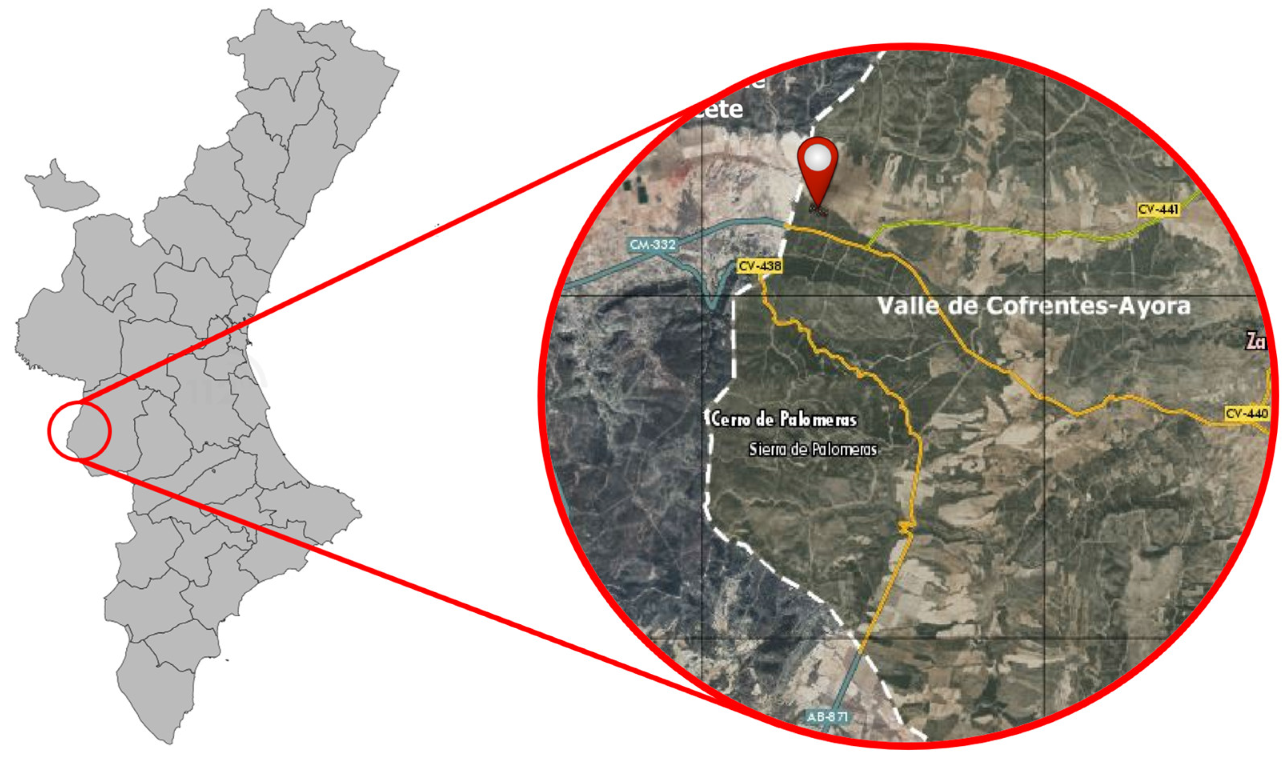
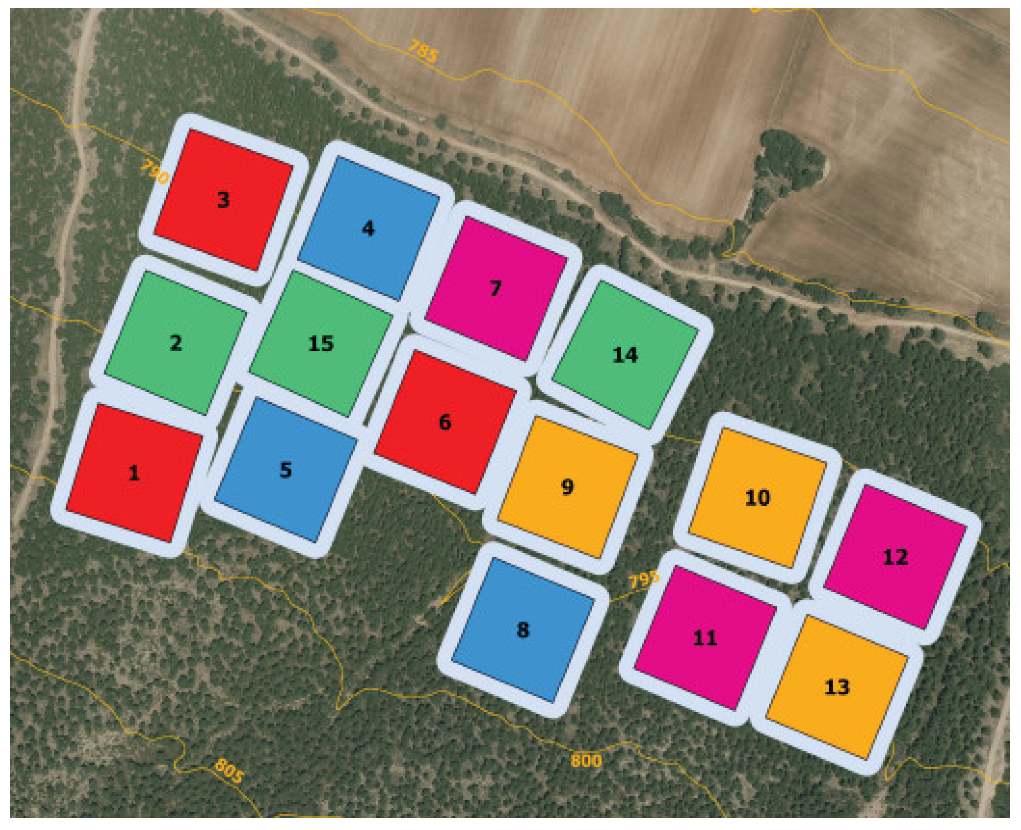
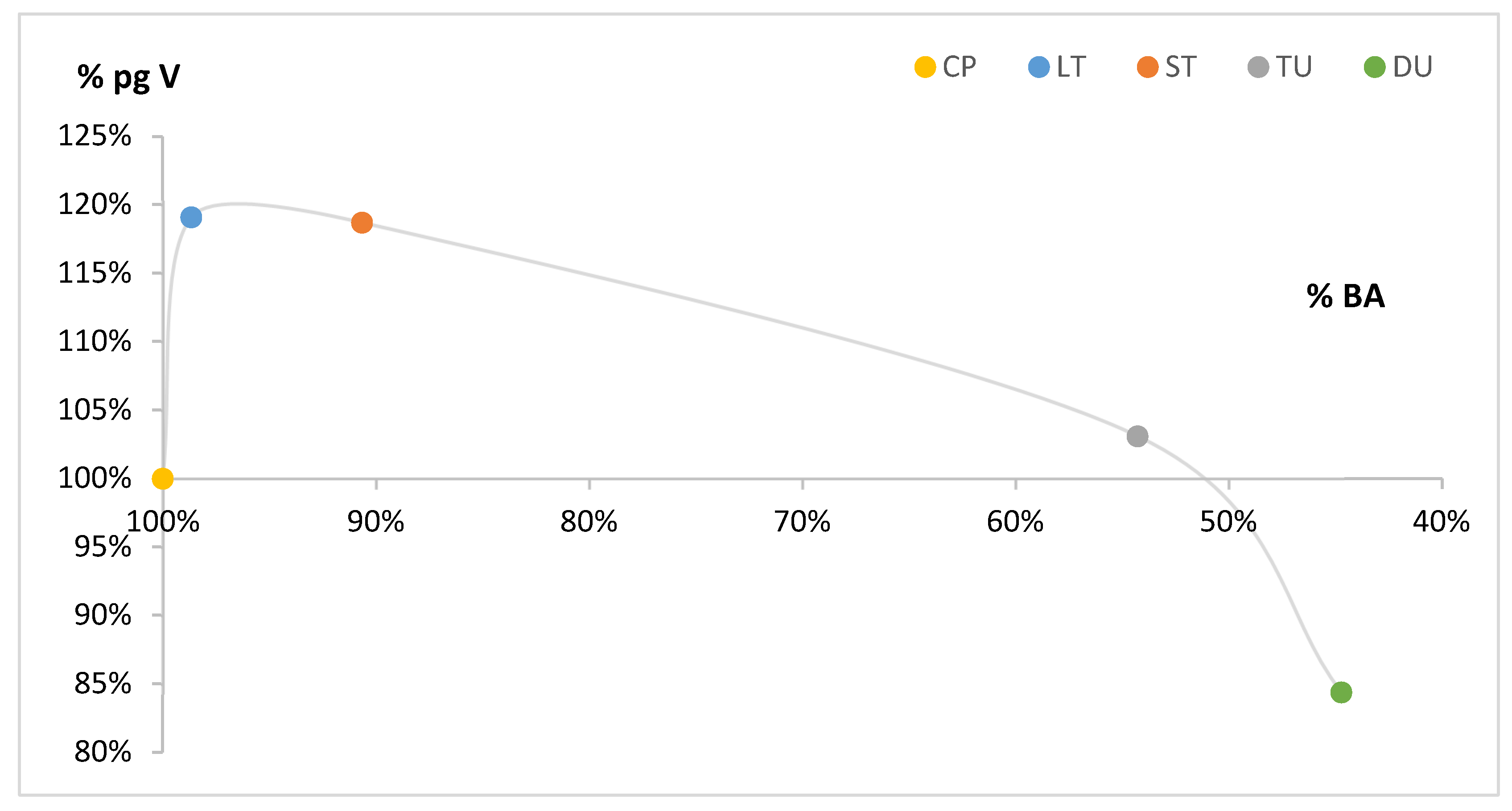
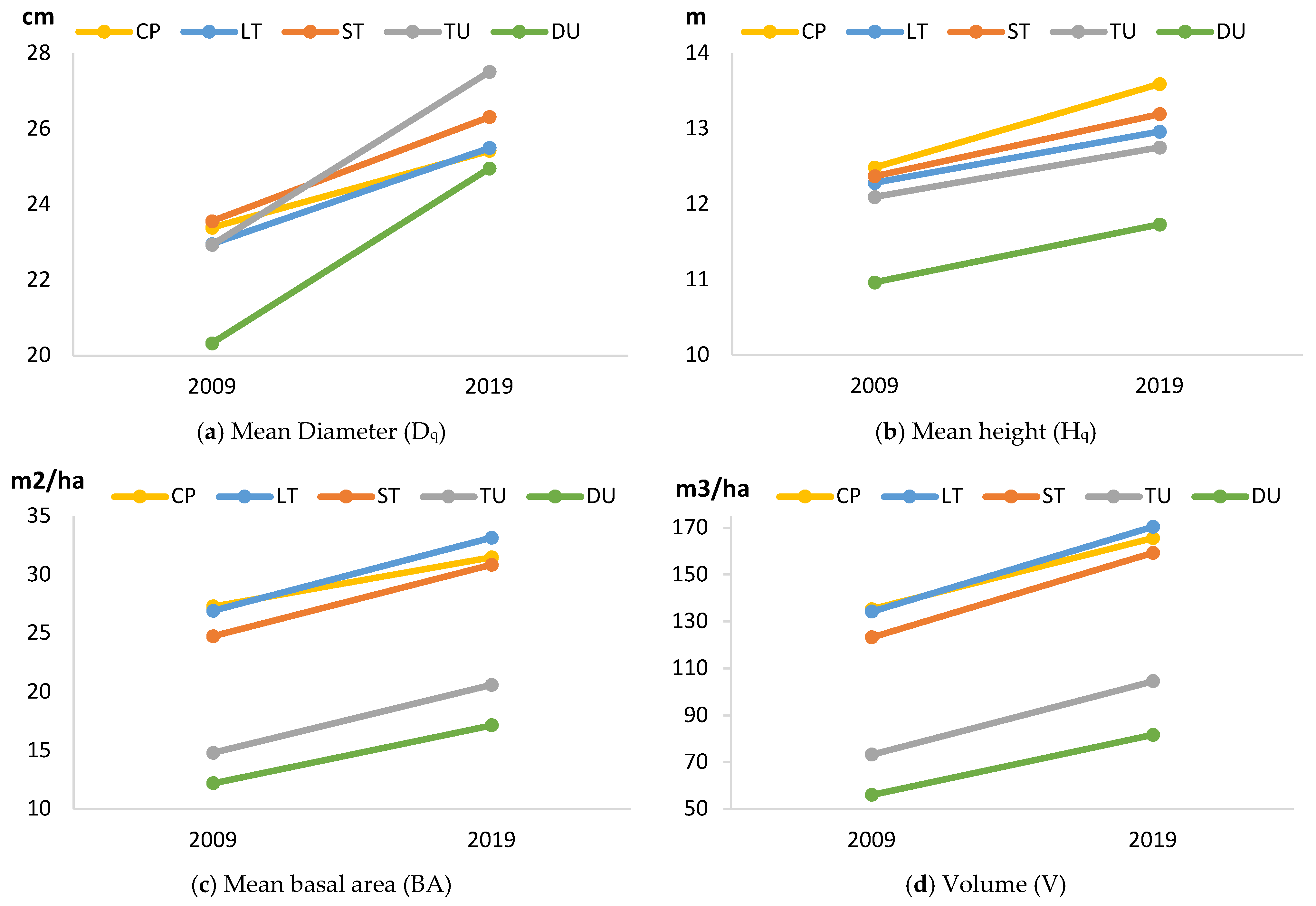

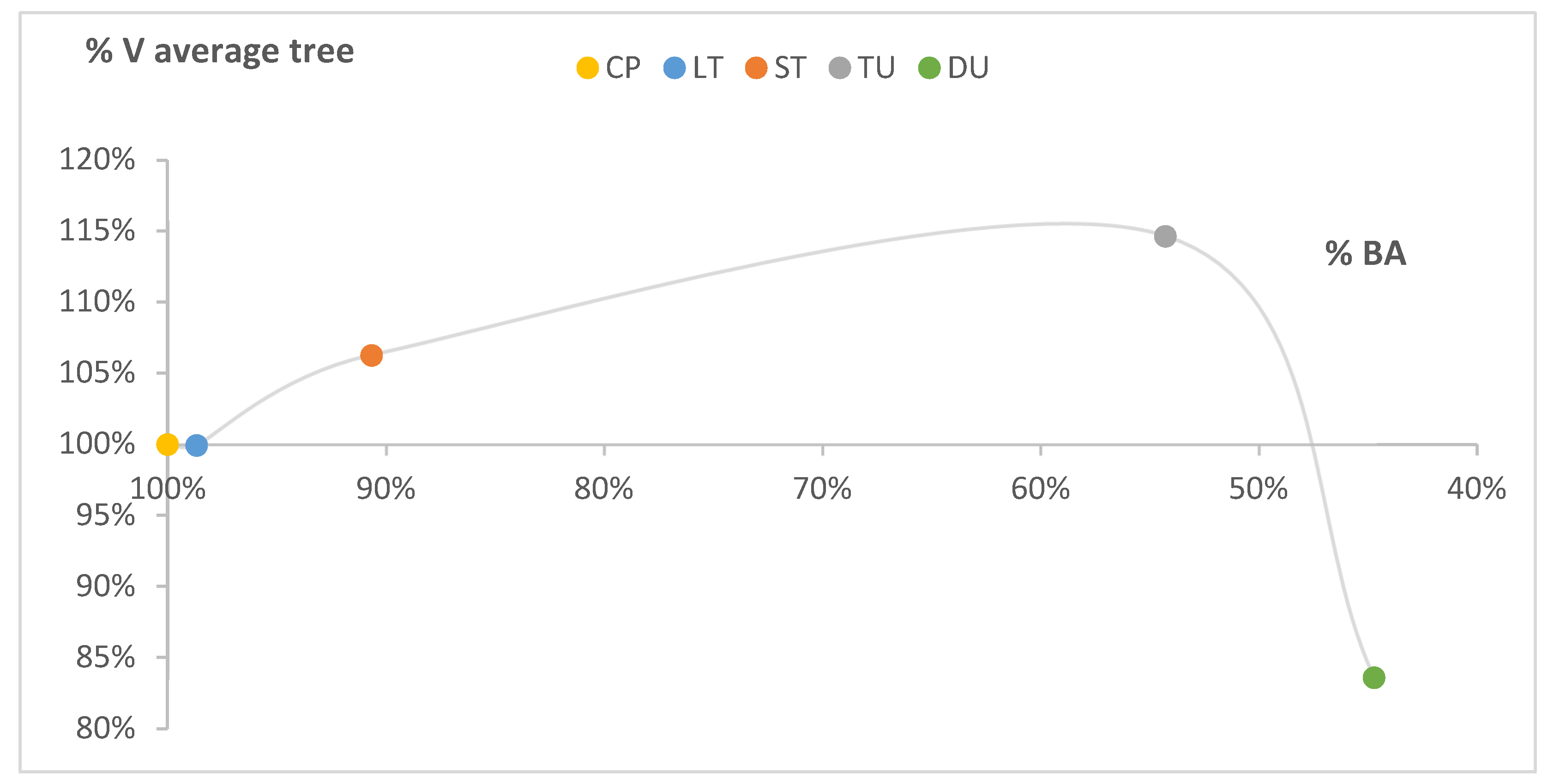
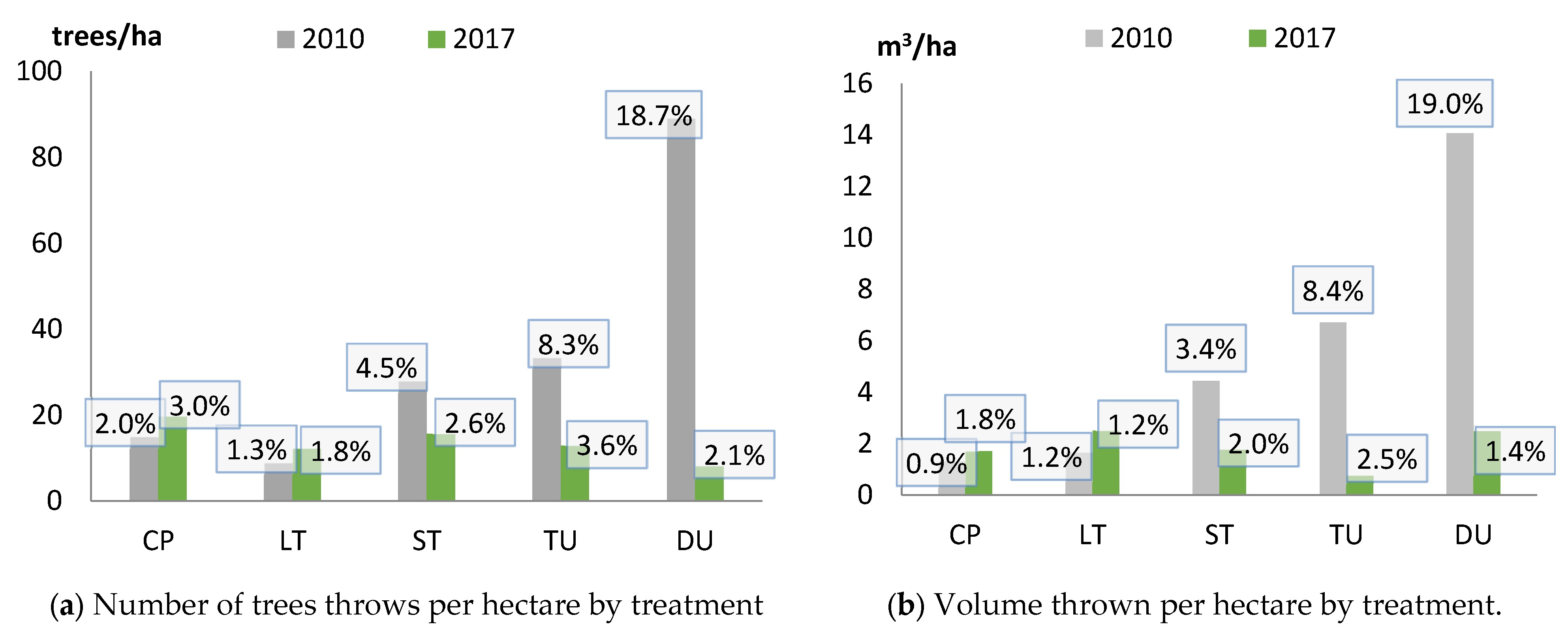
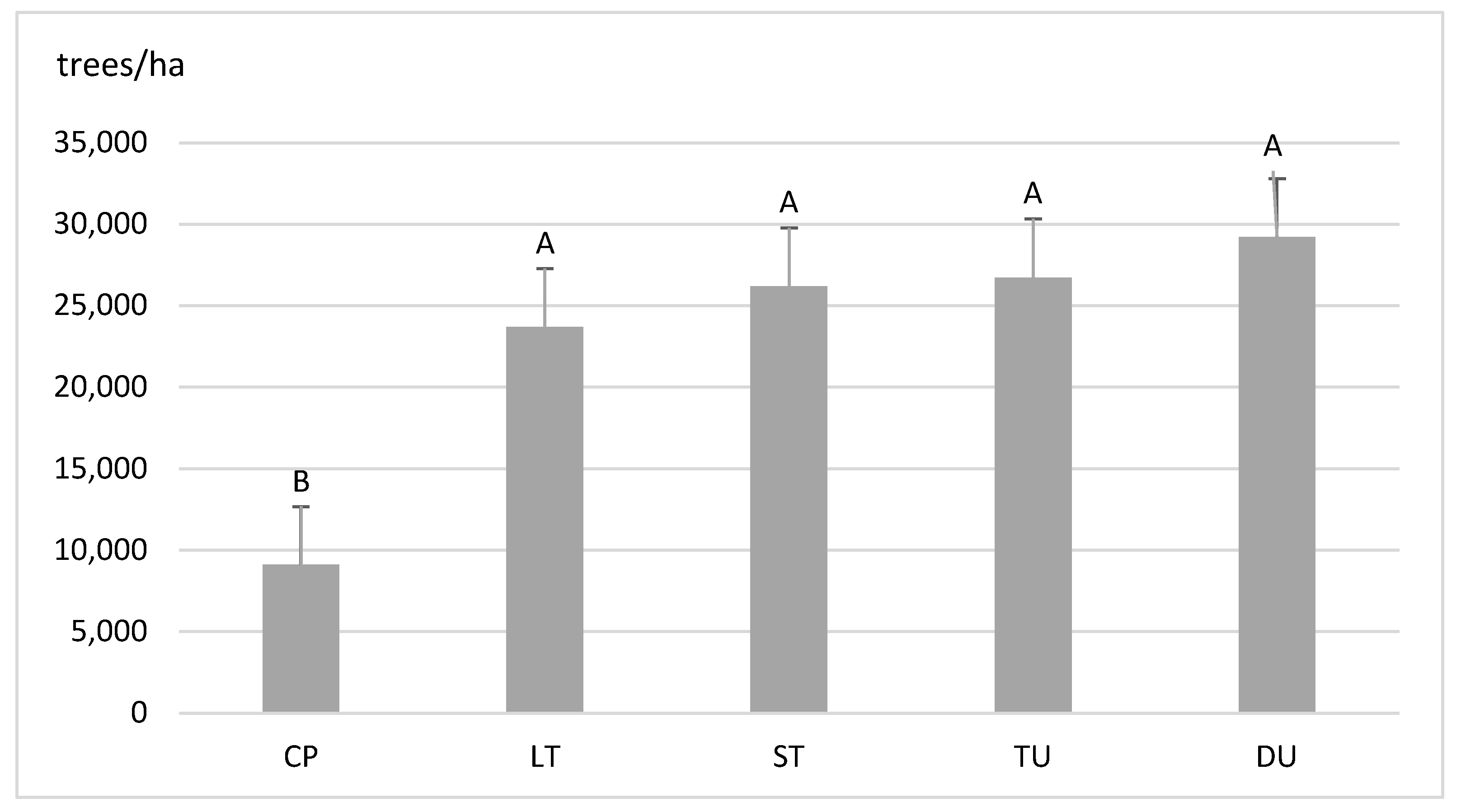
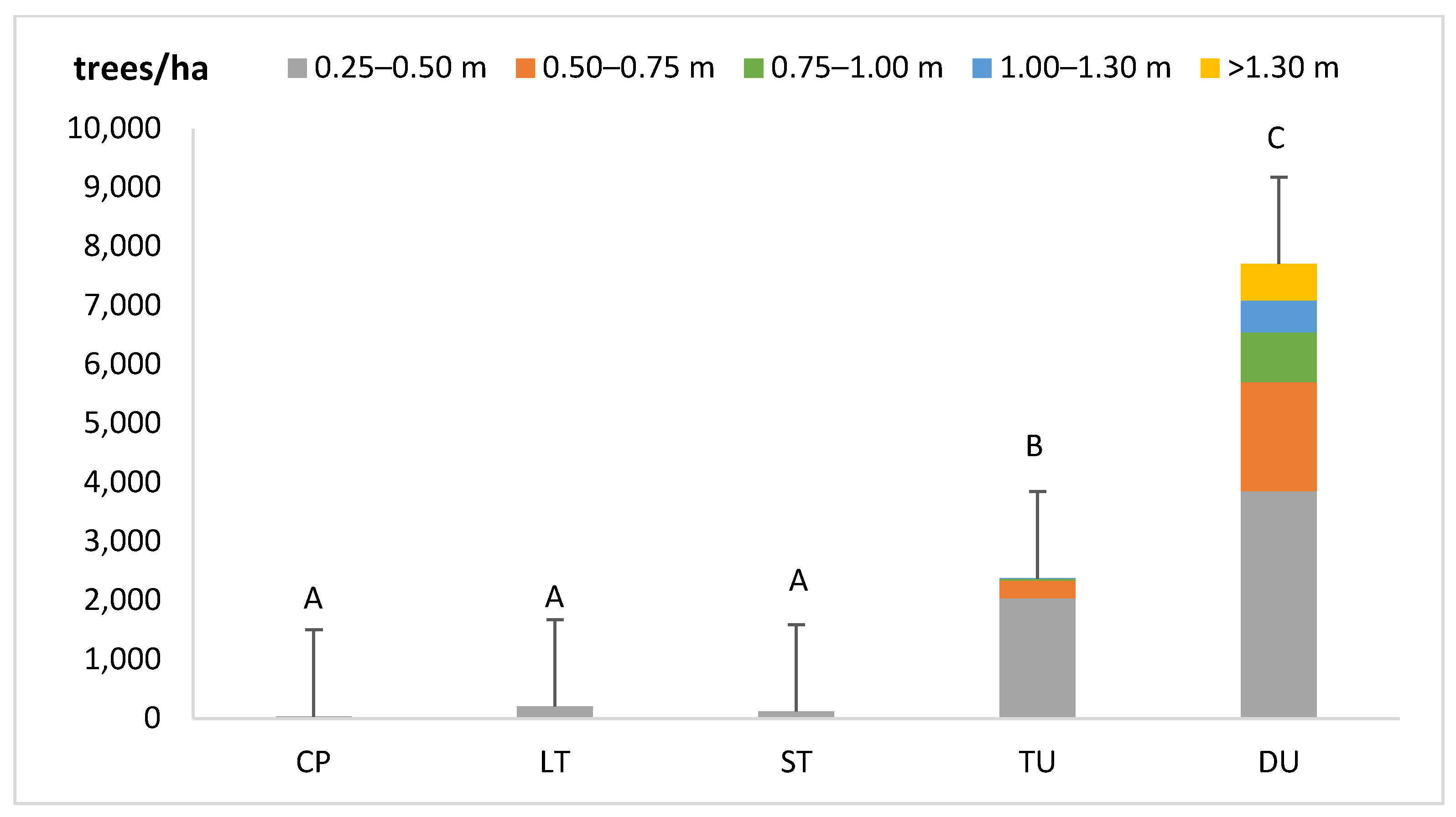
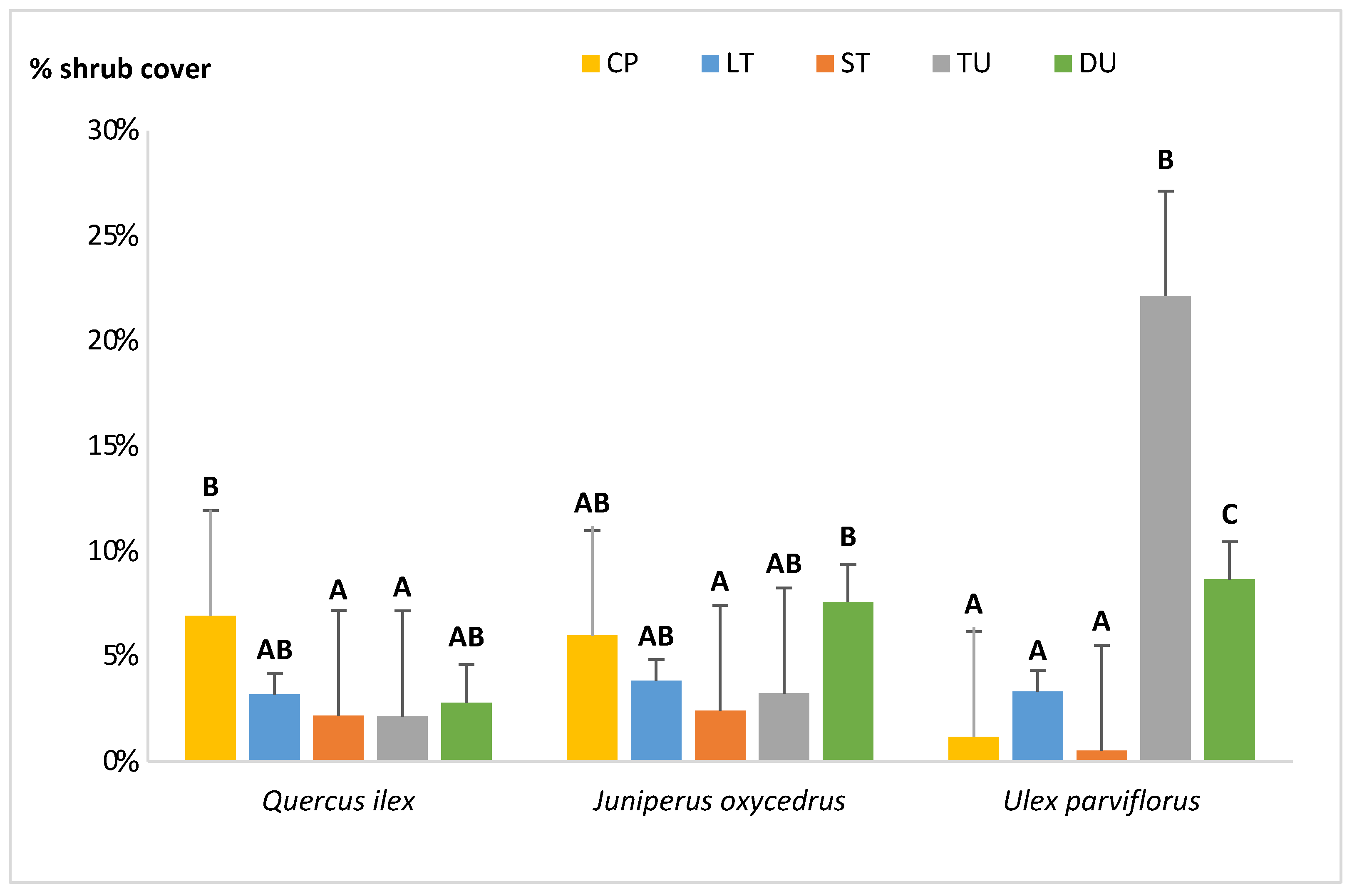
| % Removed Trees (n/ha) | % Removed Basal Area (m2/ha) | % Removed Volume (m3/ha) | |
|---|---|---|---|
| LT—Light thinning | 14% | 7% | 7% |
| ST—Strong thinning | 25% | 14% | 13% |
| TU—Transformation to uneven-aged | 44% | 38% | 37% |
| DU—Diameter-driven uneven-aged | 29% | 40% | 41% |
| Average Periodic Growth 2009 (Average of 50 Years) | Average Periodic Growth 2019 (Average of 60 Years) | Periodic Growth (Average of 10 Years) | Average Tree Volume | |||||||||||
|---|---|---|---|---|---|---|---|---|---|---|---|---|---|---|
| Dq | Hq | BA | V | Dq | Hq | BA | V | Dq | Hq | BA | V | 2009 | 2019 | |
| cm/ year | m/ year | m2/ ha-year | m3/ ha-year | cm/ year | m/ year | m2/ ha-year | m3/ ha-year | cm/ year | m/ year | m2/ ha-year | m3/ ha-year | m3/ tree | m3/ tree | |
| CP | 0.45 | 0.25 | 0.58 | 2.85 | 0.42 | 0.23 | 0.55 | 2.88 | 0.20 | 0.11 | 0.42 | 3.04 | 0.198 | 0.26 |
| LT | 0.44 | 0.24 | 0.60 | 2.99 | 0.43 | 0.22 | 0.61 | 3.09 | 0.25 | 0.07 | 0.62 | 3.62 | 0.187 | 0.26 |
| ST | 0.43 | 0.24 | 0.61 | 3.03 | 0.44 | 0.22 | 0.61 | 3.12 | 0.28 | 0.08 | 0.61 | 3.61 | 0.183 | 0.28 |
| TU | 0.43 | 0.24 | 0.53 | 2.62 | 0.46 | 0.21 | 0.54 | 2.72 | 0.46 | 0.07 | 0.58 | 3.14 | 0.182 | 0.30 |
| DU | 0.44 | 0.22 | 0.52 | 2.46 | 0.42 | 0.20 | 0.52 | 2.51 | 0.46 | 0.08 | 0.50 | 2.57 | 0.176 | 0.22 |
| After the 2009 Fellings | Trees Affected by the 2010 Windthrow | ||||||||||
|---|---|---|---|---|---|---|---|---|---|---|---|
| N | Dq | BA | V | N | Dq | BA | V | ||||
| trees/ha | cm | m2/ha | m3/ha | trees/ha | % | cm | m2/ha | % | m3/ha | % | |
| CP | 712 | 22.82 | 28.72 | 142.09 | 15 | 2.0% | 15.94 | 0.28 | 1.0% | 1.32 | 0.9% |
| LT | 686 | 22.75 | 28.05 | 139.74 | 9 | 1.3% | 21.07 | 0.33 | 1.2% | 1.66 | 1.2% |
| ST | 620 | 23.32 | 26.38 | 131.24 | 28 | 4.5% | 20.66 | 0.91 | 3.5% | 4.44 | 3.4% |
| TU | 405 | 22.81 | 16.59 | 82.03 | 33 | 8.3% | 22.88 | 1.35 | 8.3% | 6.71 | 8.4% |
| DU | 493 | 20.24 | 15.42 | 71.41 | 89 | 18.7% | 20.09 | 2.92 | 18.9% | 14.07 | 19.0% |
| After the 2010 Windthrow | Trees Affected by the 2017 Windthrow | ||||||||||
|---|---|---|---|---|---|---|---|---|---|---|---|
| N | Dq | BA | V | N | Dq | BA | V | ||||
| trees/ha | cm | m2/ha | m3/ha | trees/ha | % | cm | m2/ha | % | m3/ha | % | |
| CP | 697 | 22.94 | 28.44 | 140.77 | 20 | 3.0% | 18.11 | 0.52 | 2.0% | 2.50 | 1.8% |
| LT | 678 | 22.76 | 27.72 | 138.08 | 12 | 1.8% | 19.35 | 0.35 | 1.3% | 1.70 | 1.2% |
| ST | 592 | 23.44 | 25.47 | 126.81 | 16 | 2.6% | 20.57 | 0.51 | 2.0% | 2.51 | 2.0% |
| TU | 371 | 22.80 | 15.23 | 75.32 | 13 | 3.6% | 18.81 | 0.35 | 3% | 1.77 | 2.5% |
| DU | 404 | 20.20 | 12.49 | 57.34 | 8 | 2.1% | 16.65 | 0.17 | 1.4% | 0.77 | 1.4% |
Disclaimer/Publisher’s Note: The statements, opinions and data contained in all publications are solely those of the individual author(s) and contributor(s) and not of MDPI and/or the editor(s). MDPI and/or the editor(s) disclaim responsibility for any injury to people or property resulting from any ideas, methods, instructions or products referred to in the content. |
© 2023 by the authors. Licensee MDPI, Basel, Switzerland. This article is an open access article distributed under the terms and conditions of the Creative Commons Attribution (CC BY) license (https://creativecommons.org/licenses/by/4.0/).
Share and Cite
Rojas-Briales, E.; Oliver-Villanueva, J.-V.; Lerma-Arce, V.; Fuente, D.; Lorenzo-Sáez, E. Improving Sustainable Forest Management of Pinus halepensis Mill. Mid-Aged Stands in a Context of Rural Abandonment, Climate Change, and Wildfires. Forests 2023, 14, 527. https://doi.org/10.3390/f14030527
Rojas-Briales E, Oliver-Villanueva J-V, Lerma-Arce V, Fuente D, Lorenzo-Sáez E. Improving Sustainable Forest Management of Pinus halepensis Mill. Mid-Aged Stands in a Context of Rural Abandonment, Climate Change, and Wildfires. Forests. 2023; 14(3):527. https://doi.org/10.3390/f14030527
Chicago/Turabian StyleRojas-Briales, Eduardo, Jose-Vicente Oliver-Villanueva, Victoria Lerma-Arce, David Fuente, and Edgar Lorenzo-Sáez. 2023. "Improving Sustainable Forest Management of Pinus halepensis Mill. Mid-Aged Stands in a Context of Rural Abandonment, Climate Change, and Wildfires" Forests 14, no. 3: 527. https://doi.org/10.3390/f14030527
APA StyleRojas-Briales, E., Oliver-Villanueva, J.-V., Lerma-Arce, V., Fuente, D., & Lorenzo-Sáez, E. (2023). Improving Sustainable Forest Management of Pinus halepensis Mill. Mid-Aged Stands in a Context of Rural Abandonment, Climate Change, and Wildfires. Forests, 14(3), 527. https://doi.org/10.3390/f14030527







